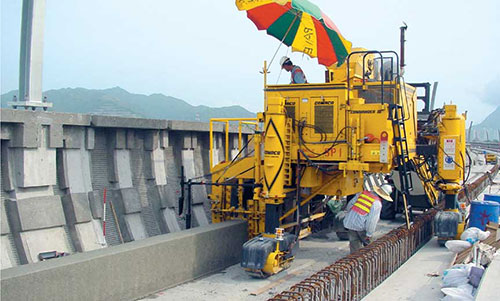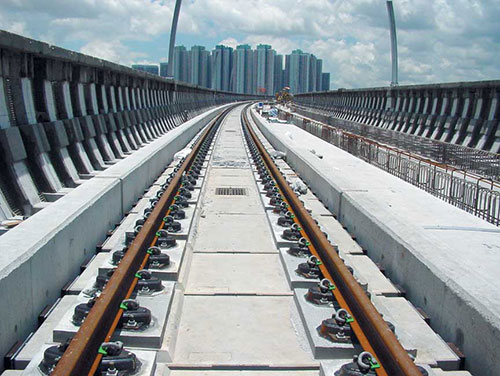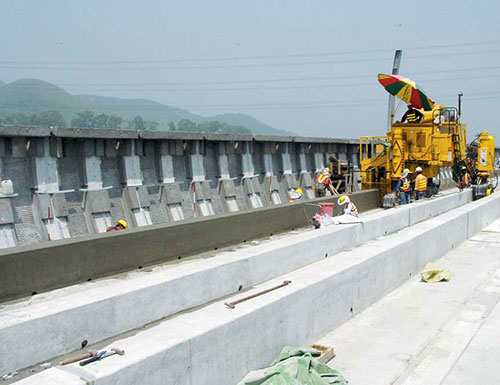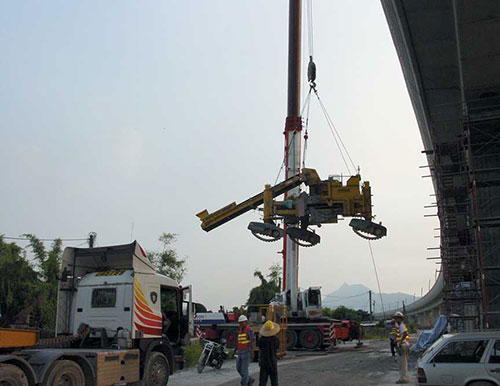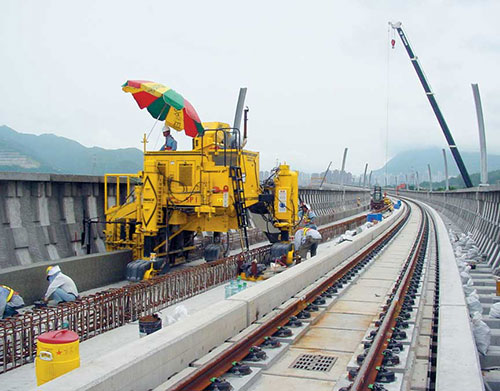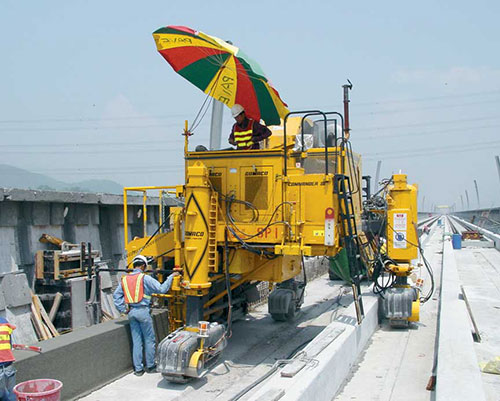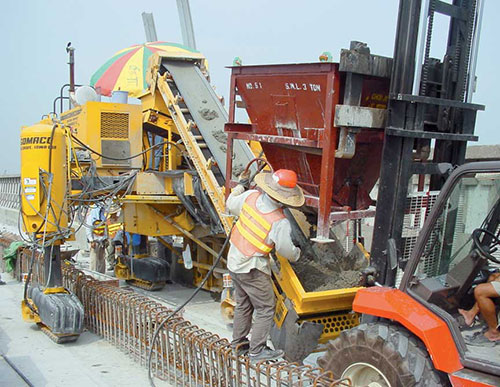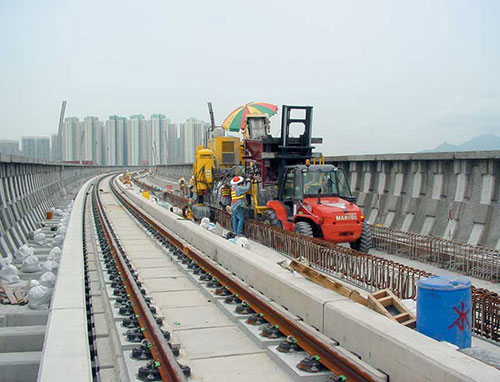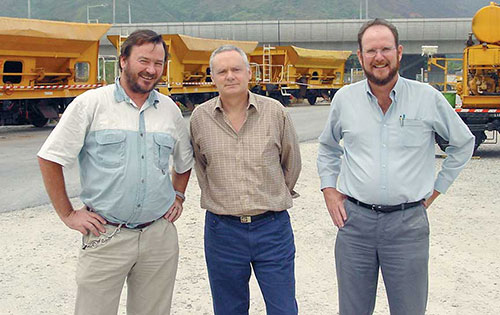GOMACO World Index --- GOMACO World 30.1 - January 2002
Keeping Trains On-Track In Hong Kong
High above the ground in New Territories, Hong Kong, the construction of one of the quietest railways in the world is commencing. The CHCQ Joint Venture of Chun Wo Holdings, Henryvicy Pty. Ltd., China Railway Construction Corporation, and Queensland Rail, are utilizing specially designed equipment and materials to complete the project.
The railway is being built for the Kowloon-Canton Railway Corporation (KCRC) and the new domestic passenger line will link West Kowloon with Tuen Mun. The project's official name is the KCRC West Rail Project–Permanent Way Northern Area.
A major consideration of the design was noise reduction. KCRC specially designed a floating track slab with rails supported on rubber/steel vibration-absorbing baseplates on precast concrete panels set on rubber bearings. The panels have rubber bearings on all four sides to reduce the amount of noise and vibration.
Before any of the rail can be set, barrier walls need to be slipformed on either side of each track. The Joint Venture team chose the GOMACO three-track Commander III, the first in Hong Kong.
"The barrier is called derailment upstand wall and has two primary functions," Adrian Terry, deputy project manager, said. "It contains the trackform within the two walls and it acts as a retaining wall to keep trains on-line should the train derail."
Approximately 9.32 miles (15 km) of derailment upstand wall will be slipformed on the viaduct. The height of the wall averages 31.5 inches (800 mm) with a width of 15.75 inches (400 mm). The wall is slipformed over reinforcing steel consisting of starter bars with T20 loops with T16 longitudinal bars.
Surface clearances are very tight in relation to the centerline of the track and the top of the rail level. Seventy-five percent of the wall is 30.3 inches (770 mm) high off the floor of the viaduct. The rest of the wall varies in height from 30.3 to 38.6 inches (770 to 980 mm).
"The finished vertical face of the derailment wall can only deviate within plus or minus 0.2 inch (5 mm) in relation to the track centerline," Terry explained. "The top of the derailment wall can only deviate within plus or minus 0.4 inch (10 mm) in relation to the top of the rail level."
"A rubber bearing fits between the wall and the floating slab on which the track is mounted," Peter Slack, project manager, said. "To stop differential compression of the rubber bearing, the walls need to be as near to vertical as possible. To keep within the compression limits of the rubber bearing, the wall face was designed to be one percent off vertical trackside and 2.5 percent off vertical on the field side."
But when your project is 35 feet (10.6 m) at its lowest point to 92 feet (28 m) at its highest off the ground, how do you get concrete up to the viaduct? And once the concrete is on the viaduct, how do you get a steady supply to a constantly moving paver?
The Joint Venture team decided the best way to provide a concrete supply to the Commander III would be through a series of steps. Concrete is delivered to the site by conventional ready-mix trucks where it is transferred into a concrete skip. The concrete skip is lifted onto the deck of the viaduct by a crane. A forklift picks up the concrete skip and transports it to the Commander III.
"This method was chosen because we had the machines available. It was also chosen for its simplicity, because not all the areas have direct crane lifting access from the ground," Slack explained. "The method had to be one that would protect the other work along the viaduct while also being able to effectively discharge the concrete from the skip while using the forklift."
Since the Commander III is the first slipform paver in Hong Kong for rail/vertical application, a major challenge of the project was developing a slipformable mix for the vertical wall.
"This application has not been slipformed in Hong Kong before. Refining the concrete mix design to suit requirements and educating the supplier to provide consistency was a challenge," Terry said. "We also had to develop and control the logistics of delivering concrete from the batching plant to the viaduct and along the viaduct to the slipform paver."
During a concrete trial phase, the mix was tested and refined. Finally, a suitable ordinary portland cement (OPC) mix with a six percent air entrainment admixture was developed. Slump averages 1.57 inches (40 mm).
"The support from GOMACO was helpful to refine the mix and train the Joint Venture operator to become familiar with the mix consistency," Slack said.
Average production rate on the project is 344 feet (105 m) during a five hour slipforming period. The remainder of the day is spent forming joints and ducts for the next pour and moving the machine.
"The issue for the project is not how fast the machine will go, but how slow it can go to enable the concrete supply to keep up with the machine," Slack said. "Our production is dictated by how fast we can receive continuous lengths of completed viaduct from the civil contractors."
The joint venture team runs a crew of 13 people with the slipforming. Their jobs include coordinating the delivery of trucks, monitoring the concrete consistency on the ground, one person on the ground and on the viaduct to arrange lifting the concrete skips, supervision, machine operator, forklift operator, chute person, and finishing work.
Four finishers work behind the Commander III applying the required steel trowel finish to complete the wall. They also re-form openings in the wall where the conduit goes through for future signal wires and drainage.
"The Commander III was chosen because of its suitability to the project," Slack said. "The main two reasons for it were to increase productivity because of our tight installation schedule and to reduce installation costs."
"This is the first Commander III machine used by the Joint Venture in Hong Kong," Terry explained. "It has met the project team's expectations quality wise. Our advice for any first-time user is to focus on your mix design and machine support systems. Also, don't underestimate the time and quantity of concrete needed to complete the trials."
Upon completion of the Permanent Way - Northern Area, approximately 4,000 tons of rail will be laid, 193,000 rubber bearings installed, 65,000 tons of precast track units placed, 16.78 miles (27 km) of GRC cable troughs laid, 2,300 tons of baseplates installed and 27,467 yd3 (21,000 m3) of ready-mixed concrete placed by its June 30, 2002, deadline.
Subscribe to Receive GOMACO World Magazine
